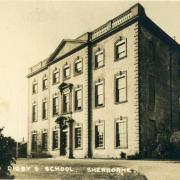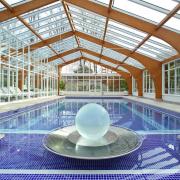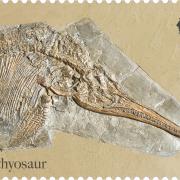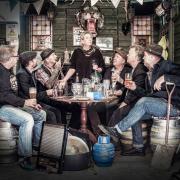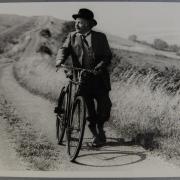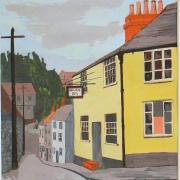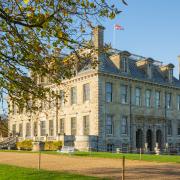If you’ve ever walked along the South West Coast Path near Worth Matravers, you might have noticed the little stone chapel on St Aldhelm’s Head, a windswept headland southwest of Swanage. This unobtrusive building sits just off the path, quietly enduring the great British weather with no shelter from the south westerlies sweeping in from the English Channel.
At first glance, it appears to be a disused, perhaps frequented by local people as a place of worship centuries ago. Peering inside, it takes a moment for your eyes to acclimatise to its shadowy interior; the only light comes through the doorway and one small window. However, St Aldhelm’s Chapel still plays an important role in Christian worship, hosting special services throughout the year as well as weddings, including mine.
One of the unusual things about the chapel is its shape. Unlike many churches, where the ‘business end’ with the altar points east, the chapel’s square shape is rotated 45 degrees, resulting in the four corners pointing to the cardinal compass points instead.
St Aldhelm’s is where nature meets with religion and spirituality. The opportunity to say a little prayer 108 metres above sea level, with the sound of waves crashing on the cliffs below, doesn’t come along often. Perching on an old wooden pew to gather your thoughts, you can admire graffiti from the 1600s etched into the central stone pillar as skylark song drifts through the open doorway. Many people before me have sat contemplating between these walls over the centuries.

Guardian of the coastline
The 12th century building itself dates to the Norman times, though it is situated among earthworks that suggest a pre-Conquest Christian enclosure and possibly a monastic settlement. A similar enclosure earthwork was found beneath the Old Castle in Sherborne, home to the first Bishop of Sherborne, St Aldhelm (circa 639 – 709).
The building’s headland location, and architectural similarities to nearby Corfe Castle, lead some historians to suggest that it may have been used as a defensive lookout to protect the Castle from potential invasions from the sea.
At times, it has been used as a chantry where masses were held to pray for the safety of sailors out at sea. Atop the roof sits a stone cross, but at one point in its history the chapel supported a beacon, indicating an important role as a navigational aid for seafarers. There is a local legend that after a bride and groom capsized while sailing around St Aldhem's Head, the bride's father built the chapel with its warning flame to protect other sailors.
The reign of King Edward VI saw the suppression of chantries in 1547, but the chapel’s use didn’t end there. Kings and nobility frequented Purbeck for hunting over the years, and it’s likely that the chapel was used as a shelter and resting place for royalty, including King John, who enjoyed hunting in the area.
St Aldhelm’s Chapel fell into disrepair in the 17th century, but a hole containing hairpins in the central pillar indicates that it was used as a ‘Wishing Chapel’ by locals who would drop small items into it and wish for the safe return of loved ones at sea. The chapel was restored in the 19th century, but by the outbreak of the Second World War, there were only occasional services held here, and the organ was carried in and out each time!

Getting married in the chapel
Today, St Aldhelm’s Chapel is used for summertime evening Celtic prayer, and there is a service on Rogation Sunday (the Sixth Sunday of Easter), where it is traditional to seek blessings for the community, particularly for its crops and food production.
It is also still used for weddings; I was fortunate enough to get married at St Aldhelm’s Chapel earlier this year. The day before the wedding, I laced up my walking boots and trekked out to meet Reverend John Cooper at the chapel, along with my fiancée and a long-suffering bridesmaid. It was during the wedding rehearsal that I realised just how many people still pass through the doors of this remote place of worship. As we stood by the altar running through what was to come, several people popped in to see what was going on. Dog walkers, hikers, and people who wanted to sit quietly for a while. One lady went as far as to enter, sit in the front pew, and take a photo or two.
There was no room for extra faces on the morning of the wedding, our friends and family filled every available space in the chapel – there are pews enough for 50 or so to be seated. Violin music, played by an old school friend, floated into every crack and time-worn hole in the Purbeck stone walls. The congregation had one hymn to sing, For the Beauty of the Earth, which seemed entirely appropriate up on the headland. Singing along to the lone violin, surrounded by everyone in their best clothes and dusty walking boots, it was impossible not to feel a deep connection with each other, the chapel, and the hundreds, if not thousands, who have celebrated over the centuries in this little Holy place.
Reverend Cooper, who officiated the service, wasn’t fazed by being asked to lead a large congregation in such a remote location. ‘It had been a secret hope that I might, one day, have the opportunity to officiate in that special place,’ he happily admits.
However, it was not without its challenges, the least of which was the one and a half mile walk to the promontory overlooking the sea. ‘Worshippers take note, there are no facilities, nor power, nor much wi-fi signal!’ he adds.

Candlelight assisted the natural daylight let in by a single window, that overlooks the Purbeck stone altar, and the open door. ‘The atmosphere as we awaited the bride was one of joyful anticipation, and the sound of a wonderful violinist reverberated around us; the acoustic is excellent.’
The wedding service also included some unexpected guests. A pair of swallows had nested in the chapel and were feeding their chicks throughout the service.
‘All I spoke to on the day felt deeply moved by the holiness of St Aldhelm’s Chapel,’ says Reverend Cooper. ‘Over 900 years of worship, welcome, and shelter from the elements, made themselves known to us on this memorable and joyful day.’
Stepping outside after the marriage service, I could see the happy faces of friends and relations with the backdrop of the sea and the Purbeck countryside. I hope that people continue to have the opportunity to enjoy this special place, just like we did, for many more centuries to come.
Find out more at saintaldhelms.co.uk




